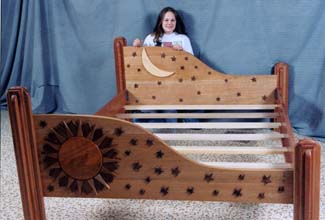
When we last checked in with George Trout, last spring, the high school woodworking teacher was a bit frustrated by the educational establishment’s sometimes condescending attitude toward woodworking. Though well respected in his school and local district, woodworking classes are sometimes looked down upon elsewhere as “manual labor.”
George is more upbeat today. His classes at Springfield High School in Springfield, Pennsylvania are more popular than ever – there’s a waiting list and over 150 kids are signed up for a program originally designed for less than half that number. Why the increase? George thinks computers are getting old now and people are turning back to traditional forms. Perhaps, but an even bigger reason is probably George’s approach to teaching. Claiming not to be much of a woodworker himself – he’s more into restoration – he calls what he teaches “problem solving.”
“If they have a project with 15 doors or drawers,” George explains, “Every one of those is a problem they need to solve. Whatever they make comes out of their head ? and they think that’s pretty cool. Having that sense of control has helped motivate some students into coming to school everyday.”
That’s one reason George’s class attracts such a wide range of students, including the class valedictorian and the homecoming queen. Another may be that the students’ work is showcased every year in the school’s annual Celebration of the Arts. Displayed among photography, artwork, theater, and music displays, the projects have become crowd pleasers for the 3,000 or so people who attend.
It’s not a cheap class. While the school provides most everything for first level kids — who mostly make clocks and vehicles — upper level students and their parents spend close to $36,000 a year on wood and hardware. And though some use planed wood, many of the students prefer to pick out wood in the rough.
“I set a day in October, after we’ve discussed our plans, and we take over the lumberyard. About half the kids in the class go along and it’s not unusual to drop $10,000 in one day. The yard, Delaware Valley Lumber Supply, treats us great,” George said.
The large furniture projects taken on by upper level students start in November and they take about six months to complete. Each project has two requirements. It has to fit into the student’s home and it has to have aesthetic appeal.
“Nothing can be carried over, so as we get closer to April or May, most of the students take advantage of evening work sessions that sometimes take us into the wee hours of next morning. Of course parents love it because they always know where the kids are.”
Seventy to 80 percent of his students go onto college. George doesn’t push his students towards careers in woodworking. The local market is very demanding and only a handful of craftsman can make a living at it. He’s stayed in touch with many of them, and though few go into the business, many stick with it as a hobby.
Still a couple of his students have decided to pursue the field.
Junior Dan Nelson needed a bed. But the four-poster he built from African ribbon mahogany also helped him win a partial scholarship to Penn State. After pursuing a degree in business management and construction design, Dan plans to start his own contracting business — he already builds kitchens and decks — and have a woodshop on the side. He’s currently working on a highboy?also for his bedroom.
Senior Kelly McConnell didn’t really need one, but one night she dreamt about a bed. When she woke up, she wrote down a description of a star-spangled, sun and moon bed. Interesting dream, but being a student of George Trout allowed her to turn it into reality. George’s lessons in problem solving and creativity also have inspired her to major in industrial education in college. Kelly’s also built a dropleaf table and a clock and is currently working on a 15-drawer dresser with no less than 384 dovetails — a new school record!





